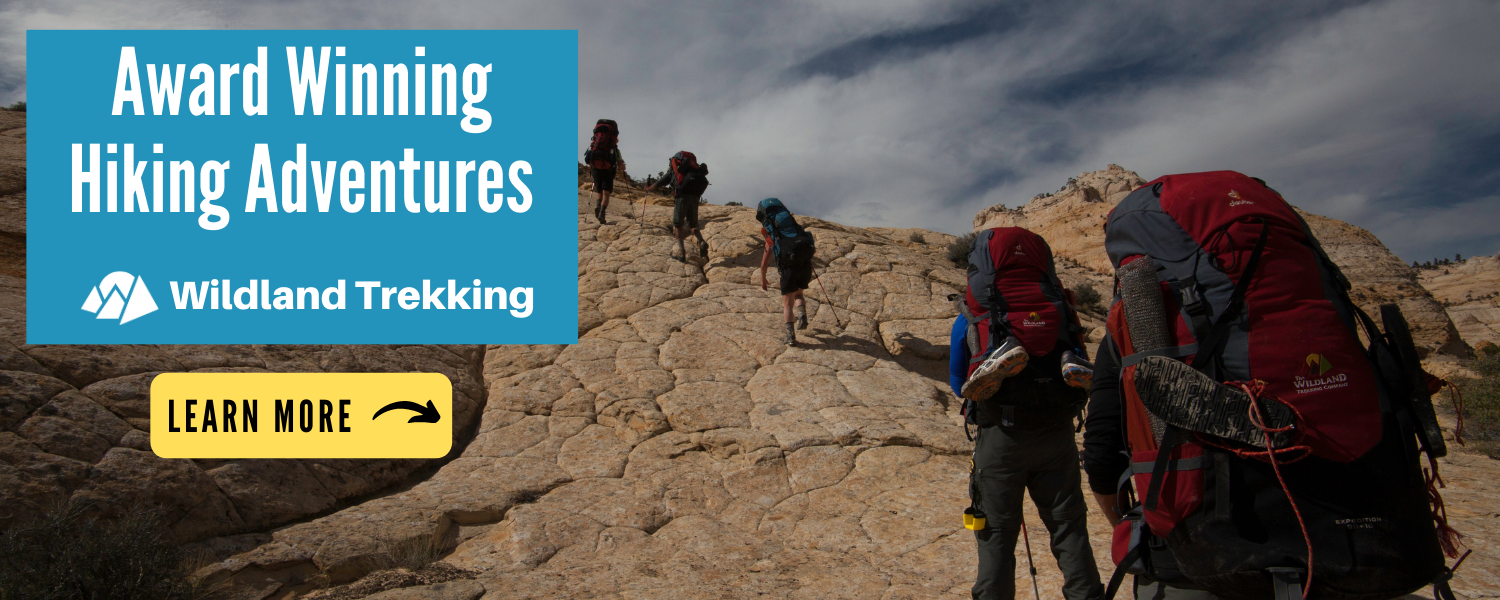5 Best Grand Canyon Backpacking Trips
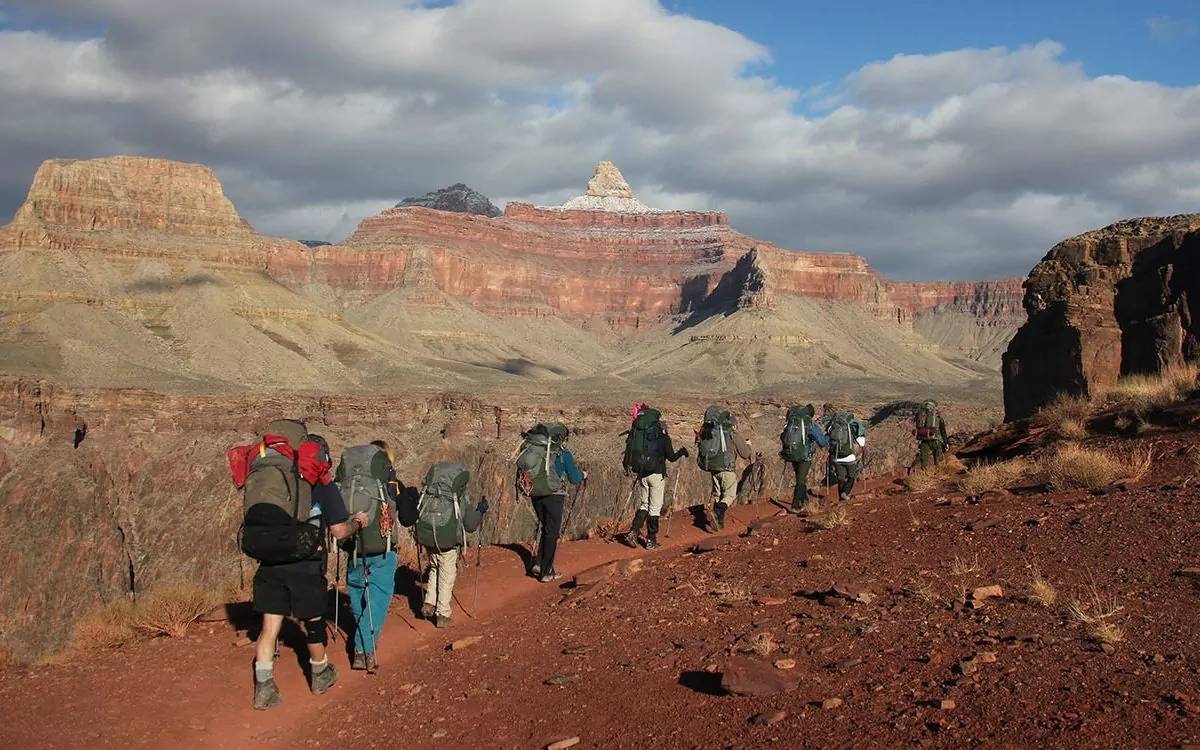
If you want to experience the Grand Canyon in the most intimate and adventurous style, then embark on a backpacking trip below the rim. Going to the Canyon and staying at the rim would be like going to Six Flags and watching the rides but never getting on one, or visiting Paris and standing outside the Louvre without ever venturing inside to see the art intimately. While the views from the rim are outstanding, the true experience offered by the Canyon is to explore its secrets, intimate details, and mind-blowing geology.
With more than 40 years of combined owner experience providing guided canyon adventures, we are experts in Grand Canyon backpacking. And we know well which trips to do, when to do them, how to them in the safest way possible…everything. We have selected our 5 favorite trips and described them in detail below. Enjoy!
| Trip | Difficulty | Days | Miles |
| Havasupai Waterfalls | Moderate | 4 | 27+ |
| Rim to Rim | Moderate | 4 | 24 |
| South Kaibab-Bright Angel Loop | Moderate | 3 | 17+ |
| Grandview-New Hance Loop | Strenuous | 4 | 18 |
| Hermit-Bright Angel Loop | Moderately Strenuous | 4 | 28 |
Guided Grand Canyon Backpacking Trips
1. Backpack to the Havasupai Waterfalls
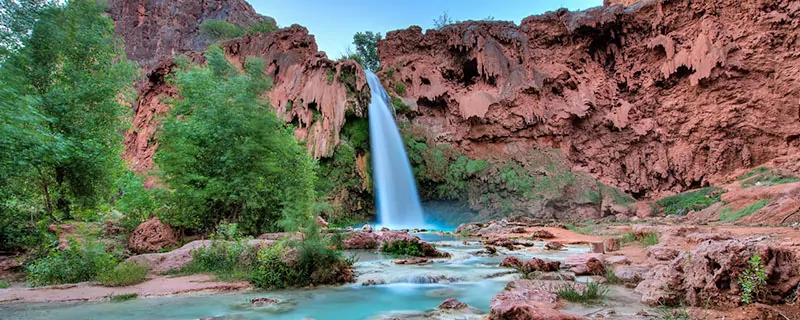
The Area
Backpacking to Havasu Falls is something everyone should do at least once. Havasu Canyon is on the Havasupai Indian Reservation outside Grand Canyon National Park. The canyon is home to 5 major waterfalls: Fifty Foot Falls, Rock Falls, Havasu Falls, Mooney Falls, and Beaver Falls. Read about all of the Havasupai waterfalls. “Havasupai” in the native language means “People of the Blue-Green Waters,” named after the mineral rich water that flows through Havasu Creek and turns the water a brilliant turquoise color.
Trip Overview
The backpacking trip is 10 miles each way to the campground, with approximately 2000 feet of elevation loss on the way in, and 2000 feet gain on the way out. You’re required by the Havasupai Tribe to stay for 3 nights (or at least pay for 3 nights – you can leave whenever you’d like of course.) The two layover days that creates can be used for swimming in the creek, relaxing in a hammock, enjoying the falls, and hiking below Mooney Falls to Beaver Falls (7 miles round trip from the campground.)
Getting There
This hike starts at the trailhead which is called “Hilltop.” The most common jumping off points to get there are Las Vegas, Phoenix, and Flagstaff.
From Las Vegas:
Take US-93 South from Las Vegas to Kingman. Head east out of Kingman on Route 66 for about 50 miles. Look for Indian Road 18 on your left and take that road. Follow it for approximately 60 miles where it ends at the trailhead.
From Phoenix:
Head north in I-17 from Phoenix to Flagstaff (2.5 hours). Follow “From Flagstaff” instructions below.
From Flagstaff:
Drive west on I-40 to Seligman. From Seligman, take Route 66 west to Indian Road 18 (approximately 50 miles.) Turn right (north) on Indian Road 18 and follow it to the end, which is the trailhead (appx. 60 miles.)
Recommended Day by Day Itinerary
Day 1: Start early (especially in the summer), drive to trailhead, hike to campground on obvious trail. You’ll hit the creek after 6 miles, the village of Supai after another 2 miles (where you need to check in), and the campground is another 2 miles down canyon on the main trail. Total hike is 10 miles, 2000 feet elevation loss.
Day 2: Hike to Beaver Falls, which is down canyon from the campground. Descend to the bottom of Mooney Falls, which is very exposed on ladders and carved out steps down a steep cliff. Continue down the creek, crossing back and forth where you can see the “trail,” which is mostly an unmaintained social trail. Beaver Falls is an obvious, beautiful waterfall with amazing swimming holes. Return the same way. 7 miles, 800 feet elevation loss/gain.
Day 3: Swim in Havasu Falls, explore Rock Falls and Fifty Foot Falls (back toward Supai on the main trail.) 2-4 miles, up to 300 ft elevation gain/loss.
Day 4: Get an early start, break camp, hike back up canyon to the trailhead. 10 miles, 2000 feet elevation gain.
Permits, Fees, Reservations…etc.
To backpack to Havsaupai, you are required to have advance reservations. Reservations are made on February 1st for that entire calendar year. They are made online and sell out very, very quickly. Payment is due at the time you make your reservation, and it is non-refundable. Read more about Havasupai reservations and fees.
Summer Heat and Flash Floods
Weather is a major consideration when planning a trip to Havasupai. Spring and fall are the best times to do the hike, and summer requires serious caution for two reasons: heat and flooding.
Heat:
Mid May through mid July is usually very hot and dry, and is the most dangerous time of year in the Grand Canyon for heat. To effectively manage the heat, start hiking very early in the morning (before sunup) and sit out the hottest part of the day in shade and/or in the water. Hike with 3-5 liters of water per person (some for dousing), and have plenty of sweet, salty snacks.
Flash Floods:
From mid July through mid September is Arizona’s monsoon season, when moisture sweeps north from the Gulf of Mexico and creates thunderstorms over the mountains and deserts of the Southwestern U.S. In monsoon season, the mornings are often clear and some time in late morning or early afternoon thunderheads begin to build. Then come the microbursts that hammer rain down in often extremely concentrated, focused areas. If a microburst opens up over the basins up canyon of Havasupai, dramatic flash floods can descend upon the campground. To prepare for these, check the weather report and if there’s a greater than 30% chance of rain, DO NOT hike below Mooney Falls. Stay above Mooney, try to camp near the upper end of the campground where you can get out quickly if you need to, and overall be conservative.
Campsites
Havasupai Campground has open, dispersed camping in a main area along the creek. You cannot reserve campsites ahead of time as everything is first-come first-serve. Try to get down there as early as possible to get a good campsite.
Hike Havasupai with a Guide
Guided backpacking trips to Havasupai are available but can be prohibited at times by the Havasupai Tribe for a variety of reasons. The tour company handles permits, gear, transportation, meals, and provides a professional guide so you can focus 100% on enjoying your adventure. Read more…
2. Rim to Rim Backpacking Trip
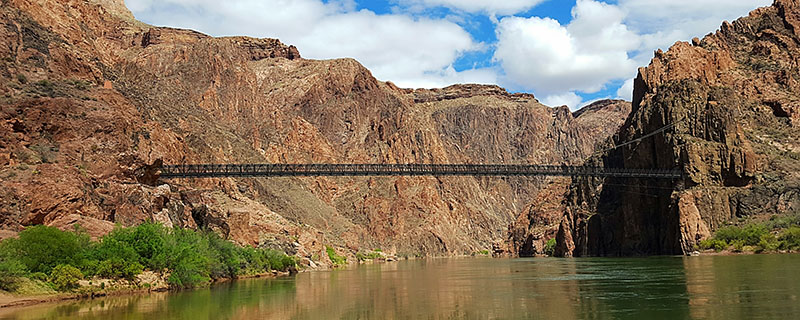
The Area
The Grand Canyon is approximately 300 miles long and is divided between Grand Canyon National Park, the Havasupai Indian Reservation and the Hualapai Indian Reservation. The famous Rim to Rim hike is in the central portion of Grand Canyon National Park known as “The Corridor.” The Corridor is where 90% of the activity inside the Canyon happens. It is where historic Phantom Ranch is located, where the most famous trails cross the Canyon, and on both sides are the busiest tourist developments – South Rim Village on the south side, North Rim facilities on the north side. The Corridor is the result of a minor fault line known as the Bright Angel Fault, where the sheer cliffs and impenetrable walls of Grand Canyon are broken, creating relatively moderate routes that have taken people in and out of from the Colorado River for millenia. The trails in the Corridor are the North Kaibab Trail, South Kaibab Trail, and Bright Angel Trail.
Trip Overview
Rim to Rim can be done as a day hike, as a lodge-based trip staying at Phantom Ranch or as a backpacking trip done in 2, 3 or 4 days. It can be done north to south, or south to north. It can be done in one direction, or back again in the opposite direction to do a Rim to Rim to Rim. All told, there are probably 30-40 different ways to do the Rim to Rim trip. This write-up is going to focus on the 4-day backpacking version of the trip, going north to south.
The North Rim opens on May 15 and closes after October 15 at the first significant snowfall at the North Rim. All of October is normally safe to plan your trip, and even the first two weeks of November are moderately safe. It’s not recommended to plan a Rim to Rim hike after November 15.
Important Note: Permits are required to camp in Grand Canyon National Park, so DO NOT attempt to do this trip without backcountry camping permits. Illegal camping fines and penalties are steep!
Getting There
This hike starts at the North Kaibab Trailhead and ends at the Bright Angel Trailhead at the South Rim, but the transportation is more complicated than that because it’s a one-way hike. It’s recommended to park your vehicle at the Backcountry Information Center at the South Rim in Grand Canyon National Park, and take Trans Canyon Shuttle to the North Rim (leaves the South Rim at 8:00 AM). The shuttle arrives at the North Rim at 12:30 PM, which is perfect for beginning the hike because you will be in the shade most of the way. When you finish the hike at Bright Angel Trailhead, your vehicle will be an easy 1/4 mile walk away from the finishing point.
To get to the South Rim:
From Las Vegas:
Take US-93 South from Las Vegas to Kingman. Head east out of Kingman on I-40 to Williams. Drive north on Highway 64 from Williams to the South Rim. Total drive time is approximately 4 hours.
From Phoenix:
Head north in I-17 from Phoenix to Flagstaff (2.5 hours). Follow “From Flagstaff” instructions below.
From Flagstaff:
Drive west on I-40 to Williams. From Williams drive north on Highway 64 to the South Rim. Total drive time is approximately 1.5 hours.
Recommended Day by Day Itinerary
Day 1: Drive to the South Rim and park your vehicle at the Backcountry Information Center. Hike approximately 10 minutes to the Bright Angel Lodge (just east of Bright Angel Trailhead), and check in for your shuttle (advance reservations are required.) You will be dropped off at the North Kaibab Trailhead at approximately 12:30 PM. Hike down the North Kaibab Trail, past Supai Tunnel, past Roaring Springs, to Cottonwood Campground. Total hike is 7 miles, 4000 feet elevation loss.
Day 2: Continue on the North Kaibab Trail down canyon toward the Colorado River. Hike past Ribbon Falls (worth taking 30 minutes to see, follow the signs), through Bright Angel Box Canyon, to Bright Angel Campground. 7 miles, 2000 feet elevation loss.
Day 3: Leave Bright Angel Campground early on the Bright Angel Trail, which will take you across the Colorado River on the Silver Bridge and then west along the Colorado River for 1.5 miles before turning south and heading up Pipe Creek, a beautiful spring-fed water source. The trail continues up Pipe Creek to the infamous Devil’s Corkscrew (a 600 foot climb on unshaded, steep switchbacks), then up across a huge, beautiful traverse and up to Havasupai Garden, where it’s recommended camping tonight. 4.5 miles, 1500 feet of elevation gain.
Day 4: Get an early start, break camp, and continue up Bright Angel Trail to the beginning of “The Switchbacks” which are 4 miles long and cover nearly 3000 feet of elevation gain. Take your time and enjoy the views, because this is a long hike. You’ll switchback higher and higher, past 3-mile resthouse (shade, water, bathrooms), then past 1.5-mile-resthouse (shade, water, bathrooms), and finally to the top. 5 miles, 3000 feet elevation gain.
Backcountry Camping Permits and Fees
To do this trip you are required to secure permits in advance. They are extremely competitive, are issued via a lottery system, and become available approximately 4 months in advance. Read more about Grand Canyon backpacking permits.
Managing Summer Heat
The main danger of hiking Rim to Rim is the heat. Much of the Rim to Rim season, May 15 – November 15, is in the hottest months of the summer. Inside the Canyon ambient temperatures often reach well into the 100+ degrees Fahrenheit range, and some days into the 110+ degrees Fahrenheit range. Those temperatures are in the shade. In the sun it can reach very, very dangerous levels.
To manage the heat, begin your hiking before sunup and sit out the hottest part of the day (10am to 4pm). Stay wet by dunking your head or t-shirt in the creeks. Drink 3-5 gallons of water of day AND twice the normal calories you normally eat. Read all of Grand Canyon’s Hike Smart Tips.
Campsites
First Night: Cottonwood Campground (CCG)
Second Night: Bright Angel Campground (CBG)
Third Night: Havasupai Garden Campground (CIG)
Hike Rim to Rim with a Guide
Guided Rim to Rim backpacking trips are available, and are a stress-free, exciting way to do this trip. The tour company handles permits, gear, transportation, meals, and provides a professional guide so you can focus 100% on enjoying your adventure. Read more…
All-inclusive Rim to Rim Trips
3. South Kaibab – Colorado River – Bright Angel
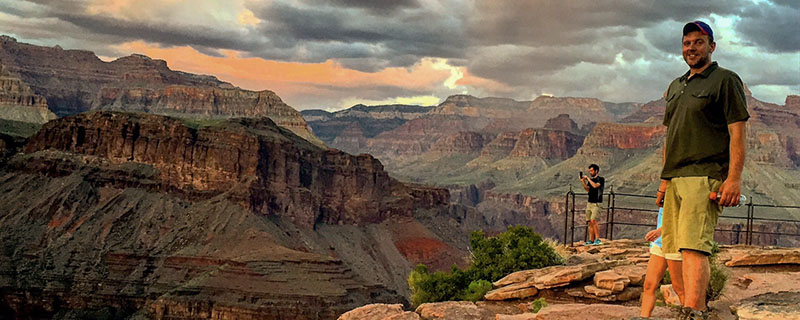
The Area
Similar to the Rim to Rim (described above), this trip is in the central portion of Grand Canyon National park known as “The Corridor.” However, varying from Rim to Rim, this hike begins and ends at the South Rim, creating a loop.
Trip Overview
The South Kaibab – Colorado River – Bright Angel Loop goes down the South Kaibab Trail, spends 1 night at Bright Angel Campground, then ascends the Bright Angel Trail to Havasupai Garden for a second night and an amazing day hike to Plateau Point. Then it finishes back to the South Rim up the second half of the Bright Angel Trail. While the Rim to Rim visits both sides of the Canyon, this trip hits the two most spectacular trails in The Corridor, and arguably the most impressive trail in the entire Canyon – South Kaibab, plus one of the best viewpoints in the Canyon, Plateau Point.
Important Note: Permits are required to camp in Grand Canyon National Park, so DO NOT attempt to do this trip without backcountry camping permits. Illegal camping fines and penalties are steep!
Getting There
This hike starts and ends at the South Rim. The starting trailhead, South Kaibab, is east of the South Rim Village but easily accessible by parking at the Backcountry Information center and catching the Grand Canyon Hikers Express Shuttle. Then, at the end of the trip, your vehicle will be a short 1/4 mile hike from the Bright Angel Trailhead.
To get to the South Rim:
From Las Vegas:
Take US-93 South from Las Vegas to Kingman. Head east out of Kingman on I-40 to Williams. Drive north on Highway 64 from Williams to the South Rim. Total drive time is approximately 4 hours.
From Phoenix:
Head north in I-17 from Phoenix to Flagstaff (2.5 hours). Follow “From Flagstaff” instructions below.
From Flagstaff:
Drive west on I-40 to Williams. From Williams drive north on Highway 64 to the South Rim. Total drive time is approximately 1.5 hours.
Recommended Day by Day Itinerary
Day 1: Drive to the South Rim and park your vehicle at the Backcountry Information Center. Catch the Hikers Express Shuttle (times vary depending on time of year and are specified on the NPS website) to the South Kaibab Trailhead. Hike down the South Kaibab Trail past the phenomenal views at Ooh Aah Point, Cedar Ridge, Skeleton Point, and the Tip-Off. Eventually, after 5-8 hours of hiking, you’ll come to the Black Bridge, which will take you across the Colorado River to Bright Angel Campground. Total hike is 7 miles, 4500 feet elevation loss.
Day 2: Get an early start and leave Bright Angel Campground heading back toward the Colorado River on the west side of Bright Angel Creek. Follow the trail as it turns right and then crosses the Silver Bridge. The trail parallels the Colorado River for 1.5 miles and then turns south up Pipe Creek, which is a wonderful, clear and cold spring-fed creek perfect for dunking your head or shirt in (or your whole body!) to stay cool. Continue up the obvious trail along the creek to an exposed, steep set of switchbacks known as The Devil’s Corkscrew. You may want to get wet before this section if it’s hot. The trail traverses a long slope with amazing views and then hits Garden Creek, which takes you to Havasupai Garden. After setting up camp at Havasupai Garden, wait until late afternoon and then hike out the Plateau Point Trail to Plateau Point for amazing views of the Canyon. 4.5 miles, 1500 feet elevation gain + 3 mile day hike to Plateau Point.
Day 3: Leave Havasupai Garden Campground early for the final ascent out Bright Angel Trail. The trail takes you up a seemingly endless series of switchbacks to the rim. There is water, shade and bathrooms approximately every 1.5 miles on this trail. At Bright Angel Trailhead you hike 1/4 miles back to the Backcountry Information Center, where your vehicle is parked. 5 miles, 3000 feet elevation gain.
Backcountry Camping Permits and Fees
To do this trip you are required to secure permits in advance. They are extremely competitive, are issued via a lottery system, and become available approximately 4 months in advance. Read more about Grand Canyon backpacking permits.
Managing Summer Heat
If you do this trip in May, June, July, August, or September, be prepared for potentially extreme heat, particularly on the South Kaibab Trail and at the bottom of the Canyon. The South Kaibab Trail does not have water anywhere on its 7 mile length and has very little shade. One possibility in the summer is to go down and back up Bright Angel Trail to have shade and water available, and skip South Kaibab altogether (if you’re hiking with kids, this is highly recommended.)
To manage the heat, begin your hiking before sunup and sit out the hottest part of the day (10am to 4pm). Stay wet by dunking your head or t-shirt in the creeks. Drink 3-5 gallons of water of day AND twice the normal calories you normally eat. Read all of Grand Canyon’s Hike Smart Tips.
Campsites
First Night: Bright Angel Campground (CBG)
Second Night: Havasupai Garden Campground (CIG)
Hike South Kaibab – Colorado River – Bright Angel with a Guide
Guided backpacking trips of this route are available, and are a worry-free, enriching way to do this trip. The tour company handles permits, gear, transportation, meals, and provides a professional guide so you can focus 100% on enjoying your adventure. Read more…
4. Grandview Trail to New Hance Trail
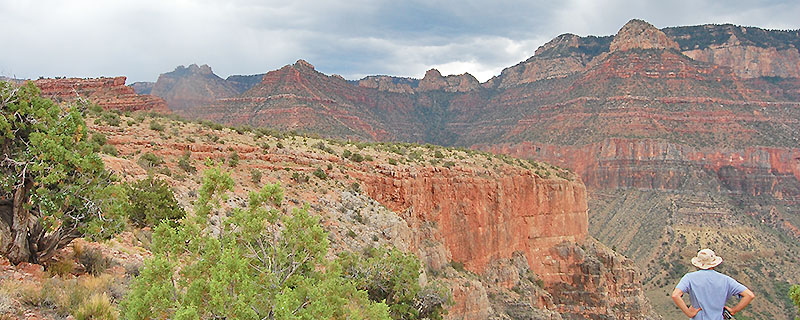
The Area
From the South Rim Village, Desert View Drive heads east for 25 miles to the East Entrance of Grand Canyon National Park. The East Entrance is where the amazing Desert View Watchtower is located, a stone tower designed by famous Southwest architect Mary Colter in the early-mid 20th century. Her Watchtower design was inspired by ancestral Puebloan people’s similar structures at Mesa Verde and Hovenweep. The Grandview Trail is about half-way between the South Rim Village and the East Entrance, and is a quiet, stunningly beautiful area that is outside the main “Corridor” section of the Canyon. The New Hance Trail is approximately 4 miles east of Grandview.
Trip Overview
Grandview Trail to New Hance Trail is an arduous and adventurous loop hike that should only be undertaken by experienced, fit backpackers and never in the summer months. It is one of the most adventurous trips in the Canyon that can be done in 4 days, and provides a very authentic experience of the wilder side of the Grand Canyon. The New Hance Trail is an extremely rugged trail with sections of steep, bouldery hiking. It’s recommended to go down Grandview and up New Hance so that on the New Hance Trail your pack is lighter and you’re hiking up instead of down, which is easier on a rugged trail.
This trip’s campsites are near spring-fed creeks, rapids on the Colorado River, and on top of the Redwall with incredible views. The last night’s camp is a dry camp so hiking with extra water on Day 3 is required.
Finally, this trip requires either two vehicles or a bicycle as there are no shuttles to these trailheads. Provided below are instructions for using a bicycle to shuttle this trip.
Important Note: Permits are required to camp in Grand Canyon National Park, so DO NOT attempt to do this trip without backcountry camping permits. Illegal camping fines and penalties are steep!
Getting There
The trailheads for this trip are on the South Rim, east of the South Rim Village.
To get to the Grandview Trail:
From Las Vegas:
Take US-93 South from Las Vegas to Kingman. Head east out of Kingman on I-40 to Williams. Drive north on Highway 64 from Williams to the South Rim. Total drive time is approximately 4 hours. At the South Rim turn east on Desert View Drive and go approximately 12 miles to the Grandview Trailhead (instructions for dropping a bike or vehicle at the New Hance Trailhead are below.)
From Phoenix:
Head north in I-17 from Phoenix to Flagstaff (2.5 hours). Follow “From Flagstaff” instructions below.
From Flagstaff:
Drive west on I-40 to Williams. From Williams drive north on Highway 64 to the South Rim. Total drive time is approximately 1.5 hours. At the South Rim turn east on Desert View Drive and go approximately 12 miles to the Grandview Trailhead (instructions for dropping a bike or vehicle at the New Hance Trailhead are below.)
Recommended Day by Day Itinerary
Day 1: Drive to the South Rim and then head east on Desert View Drive, past Grandview Trail to Moran Point to drop off a bicycle or vehicle. Leave the vehicle in the Moran Point parking lot or if you’re dropping bicycle, lock it to a tree. Then head back west approximately 4 miles to the Grandview Trailhead. Hike down the Grandview Trail past initial steep switchbacks and then through a long, rugged traverse to Horseshoe Mesa. Take the east (right-hand) fork which drops off the east side of the Mesa down steep, rugged hiking to Hance Creek, the first night’s camp. Total hike is 5 miles, 3800 feet elevation loss.
Day 2: Get an early start and hike east along the trail toward the Colorado River. Make camp on the shores of the Colorado River and mouth of Red Canyon, which forms a dramatic section of rapids, called Hance Rapids. 6.5 miles, 1100 feet elevation loss.
Day 3: Filter plenty of extra water as tonight is dry camping. Carry 6-8 liters per person, more if it’s hot. Break camp and head up Red Canyon on the New Hance Trail. Follow the trail for approximately 5 miles to the top of the Red Wall (the prominent, 5oo-feet-tall red-tinted limestone cliff that rings the Canyon.) Set up camp at the campsite on top of the Red Wall, off the trail a couple hundred feet. 5 miles, 2500 feet elevation gain.
Day 4: Continue up the New Hance Trail to the trailhead. This portion of the trail is very rugged, with bouldery sections where using your hands will be required. Walk to Moran Point. Drive vehicle or ride bike west to the Grandview Trail to retrieve the vehicle parked there. 3 miles hiking, 1800 feet elevation gain, possible 4 miles of cycling.
Backcountry Camping Permits and Fees
To do this trip you are required to secure permits in advance. They are extremely competitive, are issued via a lottery system, and become available approximately 4 months in advance. Read more about Grand Canyon backpacking permits.
When to Do this Trip
Do not do this trip during hot temperatures. Avoid it entirely in June, July and August. In May and September, proceed with caution as these months can still be very hot. If highs are over 90 in the Canyon, hike with 4 liters or more of water per person, more when dry camping the final night.
Campsites
First Night: Hance Creek (BE9)
Second Night: Red Canyon (BD9)
Third Night: Red Canyon (BD9)
Hike Grandview to New Hance with a Guide
Guided backpacking trips of this route are available, and are a worry-free, enriching way to do this trip. The tour company handles permits, gear, transportation, meals, and provides a professional guide so you can focus 100% on enjoying your adventure. Read more…
5. Hermit Trail to Bright Angel Trail
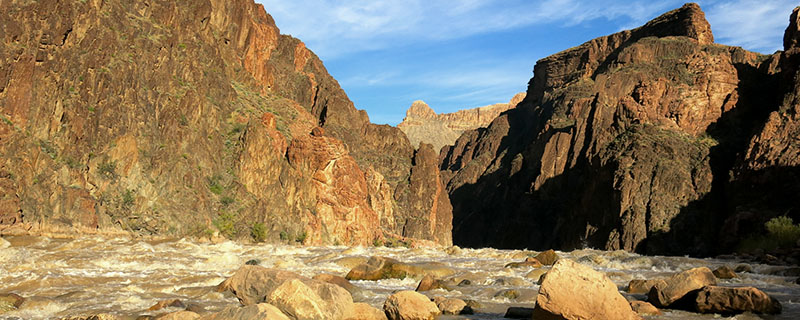
The Area
The Hermit area is west of South Rim Village at the end of Hermit Road. The area is named after Louis Boucher, the “hermit.” In the late 19th century, Boucher staked mining claims below what is now Hermits Rest. He created the original Hermit Trail and lived in the Canyon near a trickling water source 3.5 miles down, called Dripping Springs.
Helicopters are not permitted to fly east of Hermit Trail, but they are permitted to fly west of it, so in this area you will see more helicopters than in the central “Corridor” section of the Park. Hermits Rest, which marks the end of Hermit Road and is just a couple hundred yards from the trailhead, has a bathroom, gift shop, water, and food for those interested.
Trip Overview
Hermit Trail to Bright Angel Trail follows 3 trails: Hermit Trail, Tonto Trail, and Bright Angel Trail. This route is mostly secluded and relatively wild, traversing a long section of the Tonto Trail in and out of side canyons and with the ability to get down to the Colorado River to an amazing rapids section: Hermit Rapids. The views on this trip are jaw-dropping, the campsites are great, and the hiking on the Tonto Trail is mostly moderate, with the significantly difficult hiking happening on Days 1 and 4.
Important Note: Permits are required to camp in Grand Canyon National Park, so DO NOT attempt to do this trip without backcountry camping permits. Illegal camping fines and penalties are steep!
Getting There
This trip is off the South Rim in Grand Canyon National Park. Park your vehicle at the Backcountry Information Center and take the Hermit Shuttle (takes about an hour with all of the stops) to the end of Hermit Road. You’ll finish just a 1/4 mile from where you parked your vehicle.
To get to the South Rim:
From Las Vegas:
Take US-93 South from Las Vegas to Kingman. Head east out of Kingman on I-40 to Williams. Drive north on Highway 64 from Williams to the South Rim. Total drive time is approximately 4 hours.
From Phoenix:
Head north in I-17 from Phoenix to Flagstaff (2.5 hours). Follow “From Flagstaff” instructions below.
From Flagstaff:
Drive west on I-40 to Williams. From Williams drive north on Highway 64 to the South Rim. Total drive time is approximately 1.5 hours.
Recommended Day by Day Itinerary
Day 1: Drive to the South Rim and park at the Backcountry Information Center. Walk across the railroad tracks and down the main paved road to Bright Angel Trailhead. At the shuttle stop here, catch the Red Line Hermit Shuttle to the end of Hermit Road. Walk down the dirt road to the Hermit Trailhead and begin your hike. The trail drops down a long series of switchbacks (keep an eye out for fossils!) to Waldron Basin, where you can relax in the shade of a Pinyon Pine. Continue down the Hermit Trail and take the right fork toward Santa Maria Spring. Hike past Santa Maria Spring for a miles-long traverse above dizzying drops into Hermit Canyon. Eventually you’ll switchback down to the Tonto Trail, where you turn left and hike another mile to Hermit Campground. Hermit Creek has plenty of water but requires filtering. Total hike is 8 miles, 3400 feet elevation loss.
Day 2: Leave camp set up and hike down the creek to Hermit Rapids (3 miles round trip). Amazing hike! Then return to camp, break camp and head east on the Tonto Trail to Monument Creek Campground (3.5 miles). 6.5 miles, 1100 feet elevation loss/gain.
Day 3: Get an early start and hike east on Tonto Trail with plenty of water. The trail winds in and out of side canyons with precipitous drops and jaw-dropping views. Camp at Havasupai Garden, which has lots of shade and water. 11 miles, rolling ups and downs.
Day 4: Get an early start and hike up the Bright Angel Trail past countless switchbacks and shade and water every 1.5 miles. Top out at Bright Angel Trailhead. Walk 1/4 mile to your vehicle at the Backcountry Information Center. 5 miles hiking, 3000 feet elevation gain.
Backcountry Camping Permits and Fees
To do this trip you are required to secure permits in advance. They are extremely competitive, are issued via a lottery system, and become available approximately 4 months in advance. Read more about Grand Canyon backpacking permits.
When to Do this Trip
Do not do this trip during hot temperatures. Avoid it entirely in June, July and August. In May and September, proceed with caution as these months can still be very hot. If highs are over 90 in the Canyon, hike with 4 liters or more of water per person.
Campsites
First Night: Hermit Creek (BM7)
Second Night: Monument Creek (BL7)
Third Night: Havasupai Garden Campground (CIG)
Hike Hermit Trail to Bright Angel Trail with a Guide
Guided backpacking trips of this route are available, and are a worry-free, enriching way to do this trip. The tour company handles permits, gear, transportation, meals, and provides a professional guide so you can focus 100% on enjoying your adventure. Read more…
Wildland Trekking Hiking Adventures
As the world’s premier hiking and trekking company, Wildland believes in connecting people to fantastic environments in amazing ways. Grand Canyon National Park offers an array of incredible hiking and trekking experiences. Wildland Trekking provides 21 different multi-day hiking and backpacking adventures in the Canyon. Read more about our Grand Canyon trips.
To learn more about our guided backpacking trips and all of our award-winning hiking vacations, please visit our website or connect with one of our Adventure Consultants: 800-715-HIKE



